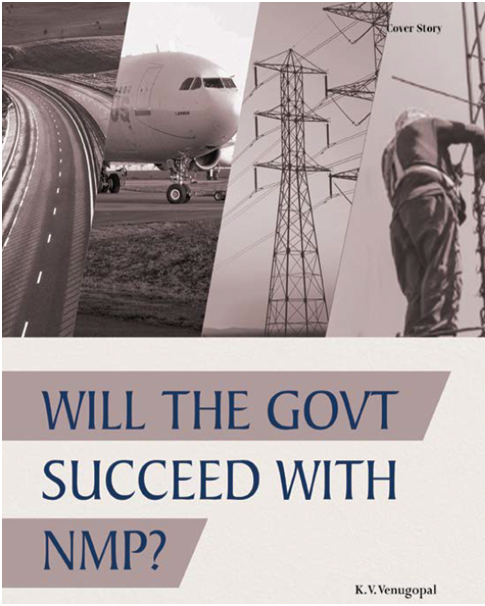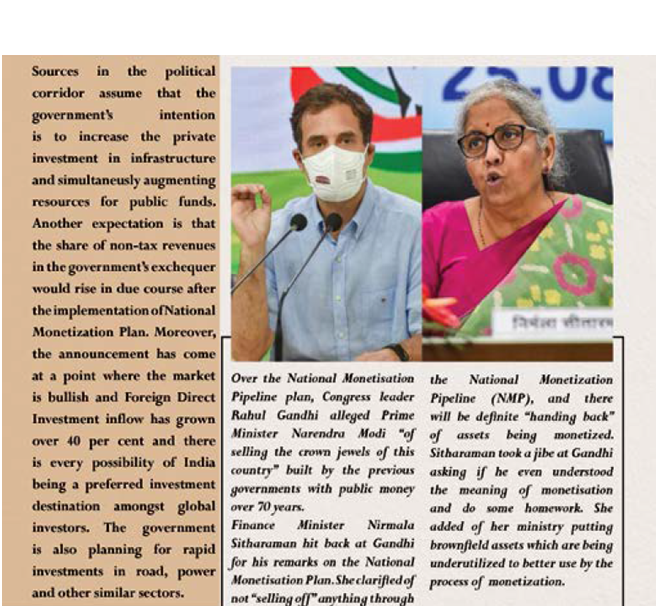
Will the Central Government’s recent announcement that it would monetize assets worth Rs six lakh crore in four years time under the National Monetization Plan or one may treat it as Asset Monetization Programme materialise? This is the question lingering in the minds of people as the Union Finance Minister Nirmala Sitharaman has released a detailed guidebook created by the Niti Adyog, which would earmark the roadmap for monetization of assets. The minister concerned has promised to facilitate the process for investors by reiterating that the government will serve as a medium-term roadmap for the asset monetization campaign.
What exactly prompted the government to opt for National Monetization Plan programme? It may be recalled that the Union Commerce Minister Piyush Goel has lambasted the corporate sector some time ago for not extending their cooperation to the government. He even went to the extent of targetting the Tata Group for the government’s discomfort when it comes to disinvestment process. Bearing this in mind and to clear the misconception of the government, the chairman of Tata Trusts, Ratan Tata, lauded the Indian Air Force for signing a memorandum of understanding with Air Bus for Rs 20,000 crore on contract to procure 56 C-295 transport aircraft for the IAF.
It may be noted that the government was annoyed over the lukewarm response from the industrialists for its proposed sale of Air India earlier, as it was hell-bent on closing the deal, unlike the previous Congress regime that failed in its effort to bail out the airline, in spite of lamenting about its massive debts, cash burden and other liabilities. The present government at the Centre with necessary debt guarantees and transfers was in a position to get two bids recently from the Tatas and Spicejet. The government needs to be hailed on its attempt to rejuvenate the loss-making units, as in the case of Air India, when the Covid-19 pandemic situation is still ensconcing the nation, if not the entire world. A massive infrastructure plan for a Delhi-Mumbai express highway is on the anvil, keeping the asset monetization issue in mind.
It is important to note, as aptly pointed out by the renowned author Chetan Bhagat that by letting private players harness public sector assets for a reasonable period, without any transfer of ownership would not harm the public and the private sector, as well as the nation. A section of political analysts like Ravindran Duraisamy and Kolakala Srinivas are of the opinon that it would be prudent to let private sector manage the public sector assets with competence by enabling the central government to generate money without privatising the assets. This commendable step would embolden the government led by Prime Minister Narendra Modi to have the best of both the summer and winter under one-roof. The government is also making it known, albeit indirectly, that it would work in tandem with the private sector, rather than opposing it just for the sake of it and to garner votes in the elections.
There is no point in apportioning the blame on the private sector for the ill-will of the economy, feel some political analysts. After all, the entrepreneurs are inclined to believe in profit-oriented business, more than of aspiring for social engineering or nation-building process. The Prime Minister had earlier urged the Chartered Accountants to work for the country, with an indirect indication to the private sector that they should ensure that the Accountants render justice to their profession. What Modi missed out the imperative was that the accountants are also accountable to their superiors. When the public private partnership is in the offing for a long time, it would only be customary for any government to expect that both the sectors cooperate with each other for maximisation of output. At times, even within the public sector, the cooperation is not forthcoming. For instance, when the former Union Finance Minister, P. Chidambaram wanted the merger of nationalised banks, a few profit-oriented banks like the Bank of India refused to merge with the loss-making banks like the Union Bank during the tenure of Manmohan Singh.
Even some vehement critics of the government admit that the decision on drastic reforms in the telecom sector would make a world of difference to the economic advancement of the nation. For instance, a four-year moratorium for companies from discharging their statutory dues, changing the definition of revenues on which levies are charged, permitting for 100 per cent investment through the automatic route, apart from signalling a go ahead to share spectrum. A step in the right direction would provide immense relief to some telecom companies that have more than adequate debt obligations owing to statutory dues. The government’s valiant attempt would instil confidence in the minds of the industrialists that here is the Prime Minister, who would leave no stone unturned to redress their ventilated grievances, if any, on the asset monetisation plan programme.
According to Niti Aaayog the assets considered for monetisation in the port sector from the financial year 2022-2025 are spread across nine of the 12 major ports. It is bein reliably learnt that so far 31 projects have been identified for private sector participation. The Union government is on the verge of offering on lease many existing brown-field infrastructure assets to private companies after assessing their capability and financial viability. If the government’s decision bears dividend, the entities engaged in cross-border trade would find an opportunity to deal with private companies as far as managing the ports and airports are concerned.
The government has offered a sovereign guarantee to help the new ‘bad bank loan’, proposed in this year’s budget to extract utility value from non-performing assets worth Rs two lakh crore from the banking system. There is no iota of doubt that some renowned economists like Bhabotsh Sen are of the view that the asset monetisation programme would only invite fiscal crisis, but the government sympathisers argue that the decision taken was correct, as the government is planning to revert to the path of fiscal consolidation within the time-period, besides creating the fiscal heft to finance the Rs 111-lakh-crore National Infrastructure Pipeline and other capita-intensive ventures.
Sources in the political corridor assume that the government’s intention is to increase the private investment in infrastructure and simultaneusly augmenting resources for public funds. Another expectation is that the share of non-tax revenues in the government’s exchequer would rise in due course after the implementation of National Monetization Plan. Moreover, the announcement has come at a point where the market is bullish and Foreign Direct Investment inflow has grown over 40 per cent and there is every possibility of India being a preferred investment destination amongst global investors. The government is also planning for rapid investments in road, power and other similar sectors.
The ruling party at the Centre denied the opposition’s charge that the country’s crown jewels were up for sale and assured that the takeover of public sector undertakings by the private sector would be at the barest minimum, apart from ensuring that bureaucratic bungling and red-tapism would not take place, besides focusing on transparency. Bearing this in mind, the government has already decided to boost economic growth by raising Rs 88,000 crore this year by leasing infrastructure assets of the central government ministries and state-run organisations under NMP.
K.V. VENUGOPAL
To read the further articles please get your copy of Eastern Panorama October issue @http://www.magzter.com/IN/Hill-Publications/Eastern-Panorama/News/ or mail to contact @easternpanorama.in


